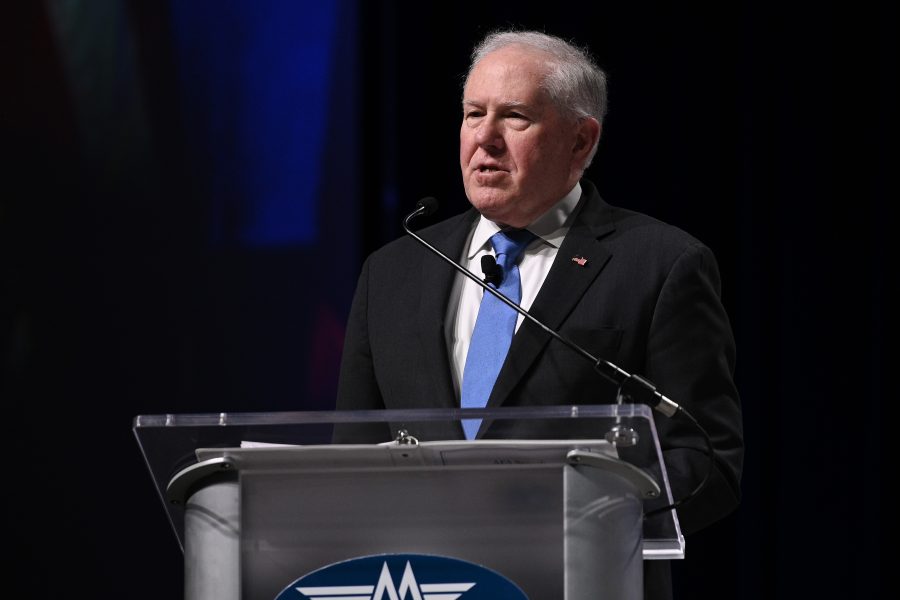AURORA, Colo.—The Department of the Air Force leadership expects its new Integrated Capabilities Command and Integrated Capabilities Office to offer competing approaches to answer emerging service needs, senior Department officials said Feb. 12 in rolling out new service organizations at the AFA Warfare Symposium.
The new Integrated Capabilities Command will be similar to other Major Commands like Air Combat Command and Air Mobility Command in that it will be led by a three-star general who reports directly to the Secretary of the Air Force and Chief of Staff. While those MAJCOMS provide forces, there are also “institutional” commands like Air Education and Training Command that carry out development, and Integrated Capabilities Command will be created in that model, Chief of Staff Gen. David C. Allvin said.
MAJCOMs like ACC will continue to provide forces—already a “big job,” Air Force Secretary Frank Kendall said—and will now offload much of the requirements process to the new Integrated Capabilities Command. This will ensure that good ideas are have a chance to rise to the attention of top-level Department leaders and are not stymied at a lower level.
There will also be an Integrated Capabilities Office, headed by Tim Grayson, special assistant to Kendall, who led the effort to organize Kendall’s Operational Imperatives, the seven capabilities areas the Air Force needs to be competitive with China. The Integrated Capabilities Office, about a 10-person shop, will have the job of finding the synergies and connective tissue between systems like the F-35 and KC-46, for example.
Asked if the two Integrated Capabilities organizations won’t butt heads, Kendall told Air & Space Forces Magazine, “They will. That’s intentional. That’s how you identify the biggest issues and bring them directly up to the top leadership for resolution.”
Acting Air Force undersecretary Kristyn E. Jones, in a keynote panel to open the conference, said these and other changes are part of what the DAF needs for Great Power Competition, and specifically, to deter China.
After analyzing “our processes, our systems, our structure and so on, against the outcomes needed, we identified several areas for improvement,” she said.
“We realized that we needed more enterprise solutions, deliberate integration,” and to “prioritize mission success over function. … And to make sure we were doing that for one Department with two services.”
The Operational Imperatives “are not going away,” Jones said. “We’re building on those efforts, but in establishing the Operational Imperatives, the need for integration was clear … across programs, across [program executive offices], across major commands, across our services.”
While separating the MAJCOMs from the top requirements-setting job, there won’t be a separation of operators from requirements, Allvin told Air & Space Forces Magazine.
“That’s the integration. That’s where that comes in,” he said, and the new organizations will also have a heightened participation from technologists and industry.
“We needed to pair operators with technical professionals,” Jones said in her keynote.
“When the Secretary wanted to focus on closing the gaps for these Operational Imperatives, there was no organization that existed.” she said. “We created a pickup team in order to move forward in these initiatives. And we’ve had great success,” but the new organizations promise to build further on the “huge leaps” the Air Force has made in communicating requirements to the Pentagon leadership and Capitol Hill.
The Integrated Capabilities Office will “be looking at capabilities across our services, not in stovepipes, enabling end-to-end creation of effects. This organization will help us to prioritize our investments and will be responsible for working with us to determine the next iteration of Operational Imperatives,” Jones said.
Another new outfit will be the Integration Development Office, which will look at capabilities put forth by industry to assess how they could be inserted into existing or emerging systems. That office will be located under Air Force Materiel Command.
Yet another new organization will be the Office of Competing Activities, which will specifically look at ways to “increase our competitive advantage” versus China and other threats, “and align our efforts with the rest of DOD,” Jones said.
It will be a “single organization focused on maintaining competitive advantage across the continuum of operations,” she added.
The Air Force also plans to share what these organizations learn with partners and allies, to aid deterrence but still protect sensitive information.
The budgetary priorities of the Air and Space Forces will also be harmonized by a new Office of Program Analysis and Evaluation, Jones said.
“We need to be able to better integrate and prioritize across two services and have one departmental narrative,” she said.
“We need to consistently improve our ability to resource our strategy through improving our programming and our budget process. We need to be able to better integrate and prioritize across two services and have one departmental narrative,” she said, and the new PA&E Shop will do that.
“The goal of this office is to enable us to better see ourselves, using analytically-based approaches. … We need to fully define the full burden cost of our capabilities,” she said; not just the platforms or acquisition programs, “but everything that’s needed to provide those capabilities across the entire spectrum,” Jones explained.
The Life Cycle Management Center, under AFMC, will shift to become the Air Dominance Systems Center. More on that transition is expected to be explained in Feb. 13 sessions.
Collectively, these changes will “lay out the next set of steps we need to do that are focused on the current force,” Kendall said in answering questions after his keynote.
“These are things we’re going to do quickly. They’re going to reorient us towards better preparation, if you will, for a conflict that just might happen, and we need to be ready for. We owe it to our men and women in uniform to get them as ready as possible in case a conflict happens.”
